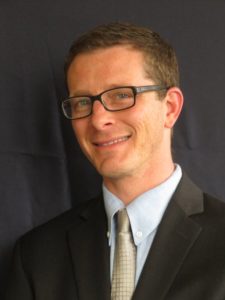2020 is a year that calls for change. Companies, industries, organizations and individuals are answering that call. The latest action comes from energy company Phillips 66, which recently announced plans to transform its San Francisco Refinery into the world’s largest renewable fuels plant.
The project is called Rodeo Renewed. It’s part of Phillips 66’s commitment to the dual challenge of providing affordable energy and addressing environmental risks.
Nik Weinberg-Lynn, manager, Rodeo Renewable Energy for Phillips 66, talks to E100 about the vision behind this massive project and what it’s like to be on the leading-edge of taking “theory to reality.”
– Nellie Betzen, The Engineering 100

 This year has been full of unexpected events, and a renewable energy project of this size is somewhat unexpected from a traditional oil & gas company. Can you talk about the strategy behind this decision?
This year has been full of unexpected events, and a renewable energy project of this size is somewhat unexpected from a traditional oil & gas company. Can you talk about the strategy behind this decision?
The business environment for the refinery has continued to dwindle negatively the last several years from a crude advantage standpoint. We’ve been working for a long time to figure out a strategy that doesn’t just get us through the next year or two years, but really sets the refinery up for the future. That type of thinking forced us to take our blinders off and do some deep dive brainstorming. The bigger the idea, the better it was. That’s what lead us to where we are today. We’re going to fully transform a refinery to run only renewable feedstocks. It’s never been done before, and it’s really exciting for Phillips 66 to lead the way.
This project is expected to produce 800 million gallons of renewable transportation fuels a year. Many people may not understand what renewable fuel is. Can you explain?
When we say renewable feedstocks, it’s a combination of waste oils, fats and greases. Think about used fryer oil from fast food restaurants, for example. We’re taking those FOGs (fats, oils and greases) and turning them into renewable diesel. We’re giving a full lifecycle to materials that would otherwise be disposed.
The remarkable thing is that petrochemically, renewable diesel looks very similar or identical to a diesel range coming from crude oil. After pretreating the fats, oils and greases and then processing them through a reaction using a catalyst, you end up with a diesel product that you can run in any diesel-driven engine. You could fill your diesel-driven engine up with renewable diesel at 100% and your engine will run… in fact, it should run even better because it has a higher cetane number, which means the fuel burns better in the engine. When you really start to dig into the chemistry behind it, the story of renewable diesel is quite amazing.
What are the expected environmental impacts of this project?
There are two big environmental categories. The first is the stationary source impact, meaning at and around the refinery. Our reconfiguration from crude oil processing to renewable processing means we will require less energy intensity and run fewer units. This will reduce our greenhouse gas footprint by 50% at the refinery site. From a local air quality standpoint, transitioning to a renewable facility will also result in an almost 90% reduction of sulfur dioxide emissions.
The second category is the benefit of having renewable diesel out on the road. Using the California Air Resources Board evaluations, a typical diesel fuel has a carbon intensity of roughly 100. The pathway we’re working on with our renewable diesel is premised to be about a 35-carbon intensity. So that’s a huge help to air quality.
Reconfiguring a whole refinery is a huge undertaking. What are the biggest engineering challenges?
It’s one thing to build a brand-new renewable diesel plant from the ground up, but it’s another to utilize existing refining infrastructure to do it. That’s an added engineering challenge. We’re thinking about everything from chemical engineering, to operability, to commercial logistics, to support functions and training.
From a purely chemical engineering standpoint, we really draw a box around the process units that will physically make the transformation to process renewables. We must understand how the catalysts are going to react, whether we have the right metallurgy, and whether we end with on-spec products. We’re heavily investing in our pre-treatment units to make sure we’re effectively removing contaminants from the fats, oils and greases to allow us to process them through the catalyst.
There are a lot of chemical engineers in the petroleum industry who understand the fundamentals of petroleum refining. They are extremely knowledgeable about distillation, breaking and bending molecules and recombing them. But there’s not a whole lot of engineering expertise around renewable feedstocks, so we have to build that up. How does the catalyst work? How do the different feedstocks react? These are all pieces to the puzzle that we haven’t put together before on a large scale, but we’re up for the challenge.
We’re in a unique time in history as we enter the energy transition, so it must be an exciting time for you as a seasoned engineer in the industry and as a San Francisco Bay Area native. What excites you most about the future?
I’ve been with Phillips 66 for about 15 years in various roles. My interest in refining is similar to a lot of chemical engineers, but I’ve really been focused on optimization and how to make the refinery run better and smarter. I started looking at renewable projects about three years ago. In fact, the whole idea behind Rodeo Renewed started with running just a small amount of renewable diesel through one refinery unit. Now, it has grown into this full transformation that we know today, and I’ve grown with the project. I started in an optimization and planning role, and now I’m the leader for all renewable energy projects at Rodeo, including a solar project we’re working on and anything renewable in the future. It’s been a journey. When I look back a couple of years ago, we were throwing out what we thought were crazy ideas of how we could run just 1,000 barrels a day of renewable fuels through the refinery and now we’re planning to do 50,000 a day. It’s pretty remarkable.
It’s also personal for me because I grew up in the San Francisco Bay Area, about 15 miles from the refinery. I’m raising my three small kids here now, so it’s rewarding to be a part of their energy future and have the opportunity to make a positive impact in our own backyard. The more I get out and talk to people in the community, the more passion I have for proving out that renewable diesel in a full-scale refinery configuration can work. When we talk about the energy transition, a lot of it has been theoretical up to this point. This is the first time that we’re taking theory and putting it into practice. What’s really impressed me about Phillips 66 through this whole project is the positivity and determination. I’ve never received comments like, ‘This will never work,’ or ‘Nobody’s going to buy this product.’ It’s always been, ‘Why don’t we go bigger?’ I really feel like the industry and our company is embracing where we go from here and the best way to get there.
